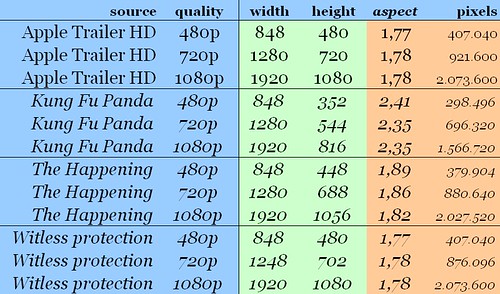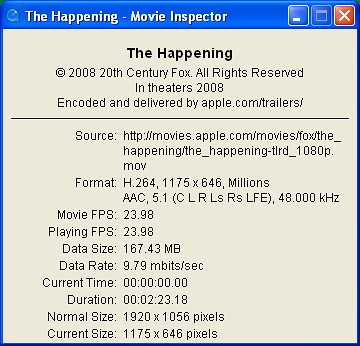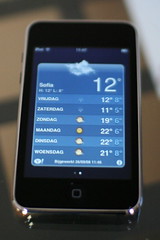Apple trailers: when 720p isn’t always 720p
28 Feb 2008One of the best places to look for high-quality movie trailers is Apple Trailers. They have lots of bandwidth and a large selection (altough they don’t have e.g. the new Indiana Jones 4 trailers, which are exclusively on Yahoo HD trailers).
Apple typically offers its HD trailers in 3 formats: 480p, 720p and 1080p. The “p” stands for “progressive” i.e. not interlaced, every frame is a full picture instead of only the odd or even lines. The 480 in “480p” stands for the number of lines in the image. 480p is roughly equivalent with DVD quality, 720p is “HD Ready” and 1080p is “Full HD”.
But let me give a concrete example of the resolution of 3 trailers:

The standard resolutions are defined for 16:9 aspect ratio. 1080 divided by 9 times 16 is 1920. When a trailer is produced in a different ratio (e.g. ‘scope’ or 2.35:1 – the wide cinema standard), then the full width is used: 1920 pixels, but the height is only 1/2.35 of this or 816 pixels, not the full 1080. If the end result must be encoded as 1920×1080, black borders have to be added on the top and bottom, which is called “letterboxing”. Of course, with Quicktime and other video file formats, a film can be encoded as 1920×816 pixels, and the player take care of displaying as wide as he can, and filling the top and bottom with black.
In concrete: 480p defines a canvas of 848×480 (852 pixels would be closer to 16:9, but for some reason Apple uses 848 as width). 720p means 1280×720 (for Witless Protection, Apple uses 1248×702 – God know why), and 1080p translates into 1920×1080.
If the trailer is not in 16:9 or 1.78:1 aspect ratio but wider, then the used width will stay the same, but the number of used lines (what gave the standards their name in the first place) changes. So for ‘scope’ trailers, 480p means 352 lines, 720p would actually have 544 lines and 1080p levels out to 816 lines. Hence: 720p isn’t always 720p.



